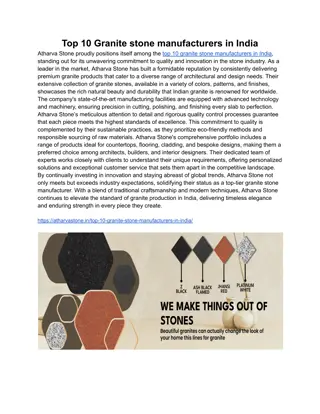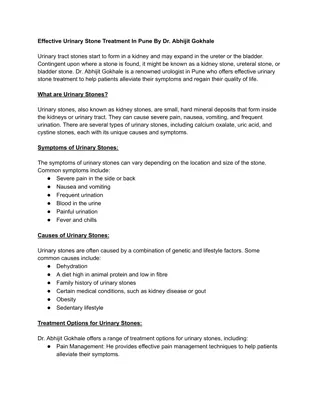Urinary Stone Formation
Factors contributing to urinary stone formation include socio-economic, genetic, dietary, and metabolic aspects. Super saturation of urine plays a key role, influenced by urinary pH and excretion of constituents. Stones can form in various locations within the urinary tract, with different mineral compositions. Emergency treatment is vital for acute renal colic episodes. Different aspects such as age, sex, and genetic factors play a role in stone episodes. Explore the complex nature of urinary stone formation and treatment through various biochemical investigations and imaging techniques.
Download Presentation

Please find below an Image/Link to download the presentation.
The content on the website is provided AS IS for your information and personal use only. It may not be sold, licensed, or shared on other websites without obtaining consent from the author.If you encounter any issues during the download, it is possible that the publisher has removed the file from their server.
You are allowed to download the files provided on this website for personal or commercial use, subject to the condition that they are used lawfully. All files are the property of their respective owners.
The content on the website is provided AS IS for your information and personal use only. It may not be sold, licensed, or shared on other websites without obtaining consent from the author.
E N D
Presentation Transcript
Kidney stones Dr Kushma Nand Renal Physician
General aspects of stone formation Biomineralisation of urinary stones are multifactorial Socio-economic Genetic Constitutional factors such as diet, pharmacologic treatment and metabolic abnormalities might act in concert
Super saturation of urine Prerequisite Solubility of different stone components depends on urinary pH and excretion of other urine constituents
General Aspects of Urinary stone formation Age sex Profession Mentality Nutrition constitution Climate race Inheritance Abnormal Renal morphology Disturbed urine flow Metabolic abnormalities Genetic factors Urinary tract infection Increased Decreased Excretion of Crystallization promoters Excretion of Crystallization inhibitors Excretion of stone forming constituents Urinary volume Physico-chemical change in the state of super saturation Abnormal crystalluria Crystal aggregation Crystal growth URINARY STONE
Ammonium urate Uric acid cystine solubility phosphate 8 6 7 5 Urinary pH
Location and form of urinary stones 97 % of all stones are localized in the Parenchyma Papilla Calyces Pelvis Pelvis and calices Ureter Only 3 % in the bladder and urethra
Location and form of urinary stones Major Constituent in % of the cases The only mineral in % of the cases Calcium oxalate Uric acid Struvite Carbonate apatitie,whitlockite Brushite Cystine Ammonium urate Protein No major constituent 20.8 8.0 2.1 1.1 1.0 0.4 0.1 0.1 - 70.4 11 6 4.8 1.0 0.4 0.5 0.8 5.1
The emergency stone Treatment of patients with acute renal colic Treatment and care of patients with urinary stones Biochemical investigations Urine and blood Imaging
Stone episodes Medical history Current age and age at first stone Profession Stone disease in relatives Associated diseases Disturbances of the metabolism of calcium HPT, RTA, Wilson's disease, MSK sarcoidosis Disturbances of the metabolism of oxalate Primary hyperoxalouria, Enteric hyperoxalouria Disturbance of the metabolism of uric acid As a result of cell death cytotoxics As a result of enzyme deficiency Gout Lesch-Nyhan syndrome As a result of alteration in excretion of uric acid Metabolic acidosis Infections Medications























